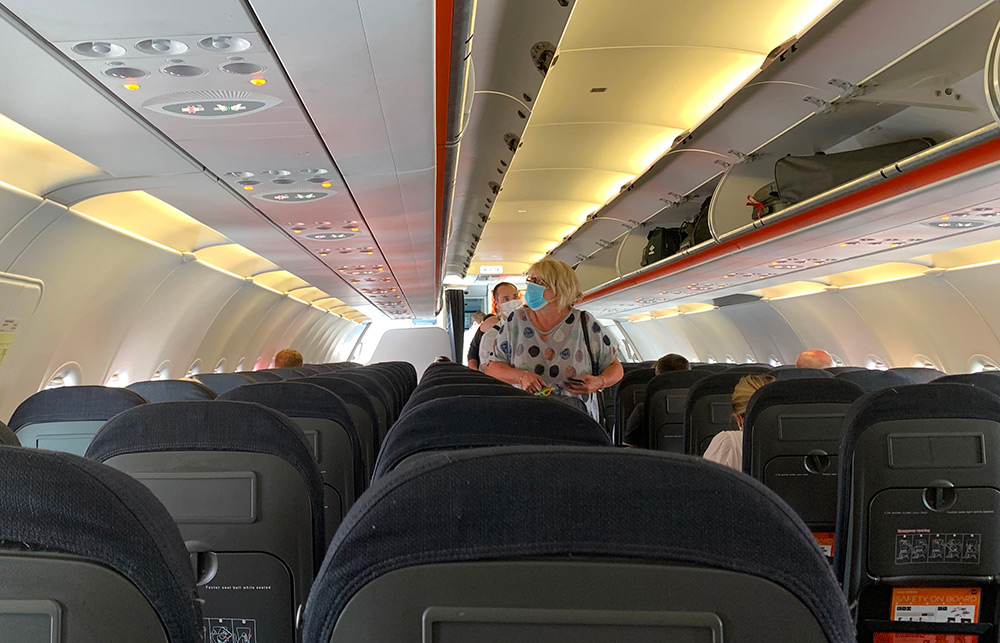
今年年初,,商業(yè)航空還是一片繁榮景象,,然而受新冠疫情影響,其業(yè)績一落千丈,,下滑速度之快令人瞠目,,全球大多航空公司和無數(shù)設(shè)備制造商也因此陷入了嚴(yán)重的財務(wù)困境之中。
最近在接受美國全國廣播公司(NBC)采訪時,,波音首席執(zhí)行官大衛(wèi)?卡爾霍恩表示,,短期內(nèi),“航空業(yè)將受到嚴(yán)重威脅”,。根據(jù)卡爾霍恩的說法,,未來2到3年,航空業(yè)的客運量都無法恢復(fù)到2019年的最高水平,,有些航空公司高管甚至做出了更為悲觀的預(yù)測,,認(rèn)為航空業(yè)可能需要3到5年的時間才能得以恢復(fù)。相比之下,,美國交通數(shù)據(jù)局的數(shù)據(jù)顯示,,“9?11”恐怖襲擊后,美國航空業(yè)花了整整三年的時間才恢復(fù)元氣,。
當(dāng)前,,新冠疫情仍在全球許多地方肆虐,各大工業(yè)國也在努力遏制新冠疫情的傳播,,盡管如此,,航空公司和設(shè)備與服務(wù)供應(yīng)商仍在探索如何從根本上重塑航空業(yè),以便乘客能放心地選擇乘坐飛機出行,。歸根結(jié)底,,要重振商業(yè)航空,還是要從恢復(fù)公眾對航空業(yè)保障出行安全能力的信心入手,。
航空業(yè)采取措施的有效性,,取決于潛在航空乘客對其措施的了解與認(rèn)可程度。由于乘客信心是航空業(yè)復(fù)蘇的關(guān)鍵所在,,航空公司哪怕有任何一點閃失都將拖累整個行業(yè)的恢復(fù)速度,。這就意味著,對航空業(yè)工作的細(xì)微修正也將被賦予極為重要的意義;審視行業(yè)內(nèi)任何工作都應(yīng)從乘客福祉出發(fā),,而非著眼于航空公司利益,。
隨著相關(guān)政策逐漸成型,再次乘坐飛機的乘客將體驗到多重安全保障,,比如機上乘客會被強制要求遮蔽口鼻并遵循社交疏離政策,,越來越多的機場也會對乘客進行健康檢查,甚至機艙布局也很可能會出現(xiàn)調(diào)整,。疫情期間,,如何讓乘客相信乘坐飛機是安全的,這是航空業(yè)所有企業(yè)所共同面臨的挑戰(zhàn),。
為此,,航空業(yè)的各大供應(yīng)商都在迅速采取行動,通過對機艙與機場航站樓中的“污染物擴散”進行模擬和建模,,他們拿出了切實可行的解決方案,。借助這些工具,航空公司將能夠找到最大程度減少傳播的方法,,并向乘客證明他們的安全保障能力,。
好消息是,現(xiàn)在所有的現(xiàn)代化客機都配備了非常先進的機艙空氣循環(huán)系統(tǒng),,并配備了醫(yī)用標(biāo)準(zhǔn)的高效微??諝膺^濾(HEPA)設(shè)備,能夠凈化空氣并保持空氣在機艙中的持續(xù)流動,。但要讓乘客更有安全感,,還得采取更多的安全措施。通過讓無形的空氣流動可視化不但能夠創(chuàng)造安全感,,還能為其安全性提供證明,。
在抗擊疫情的過程中,有很多工具的功效和價值已得到了充分體現(xiàn),。今年早些時候,,為了應(yīng)對新冠疫情,中國需要建立一些醫(yī)療設(shè)施,,中國中南建筑設(shè)計院承擔(dān)了在短時間內(nèi)建立多家臨時醫(yī)院的任務(wù),。除后勤事宜外,他們還面臨著搭建供暖,、通風(fēng),、空調(diào)(HVAC)系統(tǒng)的挑戰(zhàn),這種系統(tǒng)能將醫(yī)務(wù)人員和其他患者暴露于新冠病毒前的風(fēng)險降至最低,。
通過對空氣循環(huán)模式的實地模擬,,可以幫助設(shè)計人員找出最為有效的通風(fēng)布局,。
采用相同的模擬技術(shù),航空公司和機場也可以幫助其自身和原始設(shè)備制造商(OEM)根據(jù)機場客流和機艙布局,,來確定如何最大限度地減少污染物擴散,。航空公司可以對機艙中的氣流和病毒擴散模式進行有效模擬,并使用虛擬模型來重新設(shè)計和測試安全流程,。通過制作高清視頻,,展示其流程的工作方式,航空公司還可以實現(xiàn)與各利益相關(guān)方的有效溝通,,并提升乘客的信心。(我所在的公司——達索系統(tǒng)所提供的持續(xù)運營解決方案和乘客體驗解決方案便可解決其中一些問題,。)
長遠來看,,為強化安全性,航空業(yè)的原始設(shè)備制造商可能也會選擇對機艙本身的結(jié)構(gòu)進行改造,。但由于這種改造需要先獲得美國聯(lián)邦航空管理局的認(rèn)證,,所以需要更長時間才能付諸實踐?!??11”事件后,,原始設(shè)備制造商就對飛機駕駛艙進行了改造,以為防止外人進入,。
機場社交疏離政策的執(zhí)行方面也有很大的不確定性,,包括在安檢排隊時,需要進行哪些測試,,相關(guān)測試如何管理都是問題,。機場運營商協(xié)會首席執(zhí)行官卡倫?迪表示,機場零售商店為機場運營商貢獻了很大一塊收入,,這有助于運營商減少向航空公司收取的費用,,所以這是一個機場和航空公司所共同面臨的商業(yè)問題。
機場也可以使用相同的技術(shù)來構(gòu)建模型,、進行模擬,,從而優(yōu)化機場內(nèi)的客流、測試其安全措施和流程的有效性,。先通過“模擬機場”對計劃進行試驗,,能夠優(yōu)化運營商的資源,并最大程度地減少實施這些計劃給機場正常運營帶來的干擾,。更關(guān)鍵的是,,他們可以制作視頻,向員工及乘客證明機場環(huán)境是安全的,。
疫情后的“新常態(tài)”中,,我們需要從設(shè)計,、起飛到飛行的各個環(huán)節(jié)為乘客全面打造安全的飛行體驗。航空公司必須明確闡明為確保乘客安全都采取了哪些措施,,從而使人們確信自己乘坐飛機是安全的,。在整個航空領(lǐng)域各家公司的共同努力下,這種從起飛到降落的全程安全防控措施已經(jīng)準(zhǔn)備就緒,。是時候采取行動了,。(財富中文網(wǎng))
大衛(wèi)?齊格勒是達索系統(tǒng)負(fù)責(zé)航空與防衛(wèi)業(yè)務(wù)的副總裁。
譯者:梁宇
審校:夏林
今年年初,,商業(yè)航空還是一片繁榮景象,,然而受新冠疫情影響,其業(yè)績一落千丈,,下滑速度之快令人瞠目,,全球大多航空公司和無數(shù)設(shè)備制造商也因此陷入了嚴(yán)重的財務(wù)困境之中。
最近在接受美國全國廣播公司(NBC)采訪時,,波音首席執(zhí)行官戴維?卡爾霍恩表示,,短期內(nèi),“航空業(yè)將受到嚴(yán)重威脅”,。根據(jù)卡爾霍恩的說法,,未來2到3年,航空業(yè)的客運量都無法恢復(fù)到2019年的最高水平,,有些航空公司高管甚至做出了更為悲觀的預(yù)測,,認(rèn)為航空業(yè)可能需要3到5年的時間才能得以恢復(fù)。相比之下,,美國交通數(shù)據(jù)局的數(shù)據(jù)顯示,,“9?11”恐怖襲擊后,美國航空業(yè)花了整整三年的時間才恢復(fù)元氣,。
當(dāng)前,,新冠疫情仍在全球許多地方肆虐,各大工業(yè)國也在努力遏制新冠疫情的傳播,,盡管如此,,航空公司和設(shè)備與服務(wù)供應(yīng)商仍在探索如何從根本上重塑航空業(yè),以便乘客能放心地選擇乘坐飛機出行,。歸根結(jié)底,,要重振商業(yè)航空,還是要從恢復(fù)公眾對航空業(yè)保障出行安全能力的信心入手,。
航空業(yè)采取措施的有效性,,取決于潛在航空乘客對其措施的了解與認(rèn)可程度。由于乘客信心是航空業(yè)復(fù)蘇的關(guān)鍵所在,,航空公司哪怕有任何一點閃失都將拖累整個行業(yè)的恢復(fù)速度,。這就意味著,,對航空業(yè)工作的細(xì)微修正也將被賦予極為重要的意義;審視行業(yè)內(nèi)任何工作都應(yīng)從乘客福祉出發(fā),,而非著眼于航空公司利益,。
隨著相關(guān)政策逐漸成型,再次乘坐飛機的乘客將體驗到多重安全保障,,比如機上乘客會被強制要求遮蔽口鼻并遵循社交疏離政策,,越來越多的機場也會對乘客進行健康檢查,甚至機艙布局也很可能會出現(xiàn)調(diào)整,。疫情期間,,如何讓乘客相信乘坐飛機是安全的,這是航空業(yè)所有企業(yè)所共同面臨的挑戰(zhàn),。
為此,,航空業(yè)的各大供應(yīng)商都在迅速采取行動,通過對機艙與機場航站樓中的“污染物擴散”進行模擬和建模,,他們拿出了切實可行的解決方案,。借助這些工具,,航空公司將能夠找到最大程度減少傳播的方法,,并向乘客證明他們的安全保障能力。
好消息是,,現(xiàn)在所有的現(xiàn)代化客機都配備了非常先進的機艙空氣循環(huán)系統(tǒng),,并配備了醫(yī)用標(biāo)準(zhǔn)的高效微粒空氣過濾(HEPA)設(shè)備,,能夠凈化空氣并保持空氣在機艙中的持續(xù)流動,。但要讓乘客更有安全感,還得采取更多的安全措施,。通過讓無形的空氣流動可視化不但能夠創(chuàng)造安全感,,還能為其安全性提供證明。
在抗擊疫情的過程中,,有很多工具的功效和價值已得到了充分體現(xiàn),。今年早些時候,為了應(yīng)對新冠疫情,,中國需要建立一些醫(yī)療設(shè)施,,中國中南建筑設(shè)計院承擔(dān)了在短時間內(nèi)建立多家臨時醫(yī)院的任務(wù)。除后勤事宜外,,他們還面臨著搭建供暖,、通風(fēng)、空調(diào)(HVAC)系統(tǒng)的挑戰(zhàn),,這種系統(tǒng)能將醫(yī)務(wù)人員和其他患者暴露于新冠病毒前的風(fēng)險降至最低,。
通過對空氣循環(huán)模式的實地模擬,,可以幫助設(shè)計人員找出最為有效的通風(fēng)布局。
采用相同的模擬技術(shù),,航空公司和機場也可以幫助其自身和原始設(shè)備制造商(OEM)根據(jù)機場客流和機艙布局,,來確定如何最大限度地減少污染物擴散。航空公司可以對機艙中的氣流和病毒擴散模式進行有效模擬,,并使用虛擬模型來重新設(shè)計和測試安全流程,。通過制作高清視頻,展示其流程的工作方式,,航空公司還可以實現(xiàn)與各利益相關(guān)方的有效溝通,,并提升乘客的信心。(我所在的公司——達索系統(tǒng)所提供的持續(xù)運營解決方案和乘客體驗解決方案便可解決其中一些問題,。)
長遠來看,,為強化安全性,航空業(yè)的原始設(shè)備制造商可能也會選擇對機艙本身的結(jié)構(gòu)進行改造,。但由于這種改造需要先獲得美國聯(lián)邦航空管理局的認(rèn)證,,所以需要更長時間才能付諸實踐?!??11”事件后,,原始設(shè)備制造商就對飛機駕駛艙進行了改造,以為防止外人進入,。
機場社交疏離政策的執(zhí)行方面也有很大的不確定性,,包括在安檢排隊時,需要進行哪些測試,,相關(guān)測試如何管理都是問題,。機場運營商協(xié)會首席執(zhí)行官卡倫?迪表示,機場零售商店為機場運營商貢獻了很大一塊收入,,這有助于運營商減少向航空公司收取的費用,,所以這是一個機場和航空公司所共同面臨的商業(yè)問題。
機場也可以使用相同的技術(shù)來構(gòu)建模型,、進行模擬,,從而優(yōu)化機場內(nèi)的客流、測試其安全措施和流程的有效性,。先通過“模擬機場”對計劃進行試驗,,能夠優(yōu)化運營商的資源,并最大程度地減少實施這些計劃給機場正常運營帶來的干擾,。更關(guān)鍵的是,,他們可以制作視頻,向員工及乘客證明機場環(huán)境是安全的,。
疫情后的“新常態(tài)”中,,我們需要從設(shè)計,、起飛到飛行的各個環(huán)節(jié)為乘客全面打造安全的飛行體驗。航空公司必須明確闡明為確保乘客安全都采取了哪些措施,,從而使人們確信自己乘坐飛機是安全的,。在整個航空領(lǐng)域各家公司的共同努力下,這種從起飛到降落的全程安全防控措施已經(jīng)準(zhǔn)備就緒,。是時候采取行動了,。(財富中文網(wǎng))
大衛(wèi)?齊格勒是達索系統(tǒng)負(fù)責(zé)航空與防衛(wèi)業(yè)務(wù)的副總裁。
譯者:梁宇
審校:夏林
For an industry flush with success at the start of 2020, it’s remarkable how quickly commercial aviation went into a nose dive because of the COVID-19 health crisis, which has left most of the world’s airlines and countless equipment manufacturers in severe financial distress.
In the short term, “the threat to the airline industry is grave,” Boeing CEO David Calhoun recently told NBC News. According to Calhoun, passenger traffic isn’t expected to rebound to its record 2019 levels for two to three years, with some airline executives anticipating a more pessimistic three-to-five-year recovery. For comparison, it took nearly three full years following the terrorist attacks on Sept. 11, 2001, for the airline industry to rebound, according to the U.S. Bureau of Transportation Statistics.
Carriers and their equipment and services suppliers are exploring how to fundamentally rethink their industry to make travelers feel safe again, even as industrialized countries are still trying to wrest control of the pandemic that continues to ravage other parts of the world. Ultimately, resuscitating commercial aviation must start by restoring public confidence in the industry’s ability to make the end-to-end travel experience as safe as possible.
Whatever combination of steps the aviation industry takes will be only as effective as its effort to inform would-be air travelers of those actions and how they’re perceived in aggregate. Even small missteps by carriers could slow the recovery, with passenger confidence the linchpin to success. This means that the stewardship of aviation’s delicate course correction will be extremely important; everything the industry does will need to be seen through the lens of passengers’ well-being, not the airlines’.
As it is shaping up, layers of safety are what the flying public can expect to experience as they resume air travel. This includes mandatory face coverings, social distancing, passenger health checks in a growing number of airports, and in all probability the reconfiguration of aircraft cabin interiors. Moreover, how to convince air travelers that flying commercially is safe amid the virus’s spread is a challenge shared among all industry players.
On this last point, key vendors to the airline industry are quickly stepping up by offering ready-to-go solutions to leverage simulation and modeling of “contamination dispersal” in aircraft cabins and airport terminals. These tools should help airlines figure out and demonstrate to passengers how they are minimizing community spread.
The good news is that today, all modern passenger jets already have very sophisticated cabin air systems with hospital-standard high-efficiency particulate air (HEPA) filters, so air is cleaned and kept moving on a continuing basis. A greater sense of security, however, requires taking an additional step. Today, seeing the unseen—how air flows—can create more than a sense of safety but visible proof of safety.
Tools that can do this have already proven their abilities in the ground fight against COVID-19. When China needed to erect several medical facilities earlier this year in response to the coronavirus outbreak, the Central South Architectural Design Institute Company of China undertook the task of erecting multiple makeshift hospitals on an accelerated timeline. In addition to the logistical challenge, an HVAC (heating, ventilation, and air conditioning) system that minimized the risk of exposing hospital staff and noninfected patients to COVID-19 was imperative.
By using real-world simulation of air circulation patterns, designers were able to determine which of their proposed ventilation layouts would be the most effective.
Airlines and airports can employ the same simulation technology to help airlines and original equipment manufacturers (OEMs) establish how to minimize the dispersal of contaminants, based on different cabin passenger layouts and traffic patterns in airports. (For an example, see this video.) Airlines can efficiently simulate airflow and virus diffusion patterns in an aircraft cabin and work with a virtual model to redesign and test safety procedures. By creating high-rendering videos to show how their procedures work, they can communicate effectively with all stakeholders and increase passenger confidence. (My company, Dassault Systèmes, offers solutions that address several of these issues, including our Keep Them Operating and Passenger Experience solutions.)
Longer term, aviation’s OEMs may also choose to structurally modify the cabin itself to enhance onboard safety. But this action would take longer to implement, since the Federal Aviation Administration would have to certify any such changes, as was the case following 9/11, when OEMs upgraded cockpit doors to make them virtually impenetrable.
Another area of great uncertainty is the extent to which social distancing will be required in airports, including security queues—what tests will be required, and how will they be administered. This is a commercial issue for both airports and airlines, since retail outlets provide a lucrative source of revenue for airport operators, which helps reduce the charges made to airlines, according to Karen Dee, CEO of the Airport Operators Association.
Airports can use the same technology to create simulated models that help them optimize passenger flow and test the effectiveness of safety measures and procedures. By trying out their plans in a “virtual twin” of the airport first, they can optimize resources and minimize disruption when implementing those plans. Crucially, they can also create videos to demonstrate to w
orkers and passengers that the environment is safe. (For an example of such a simulation, see this video.)
In the “new normal” that follows the pandemic, passenger safety needs to be built in at every stage, from design to departure and flight. And the steps that are taken to ensure passenger safety must be clearly articulated to give people assurances that they will be safe when they fly. Thanks to the combined efforts of companies across the aerospace ecosystem, that end-to-end approach is already in place. Now it’s time to act.
David Ziegler is the vice president of aerospace and defense at Dassault Systèmes.






